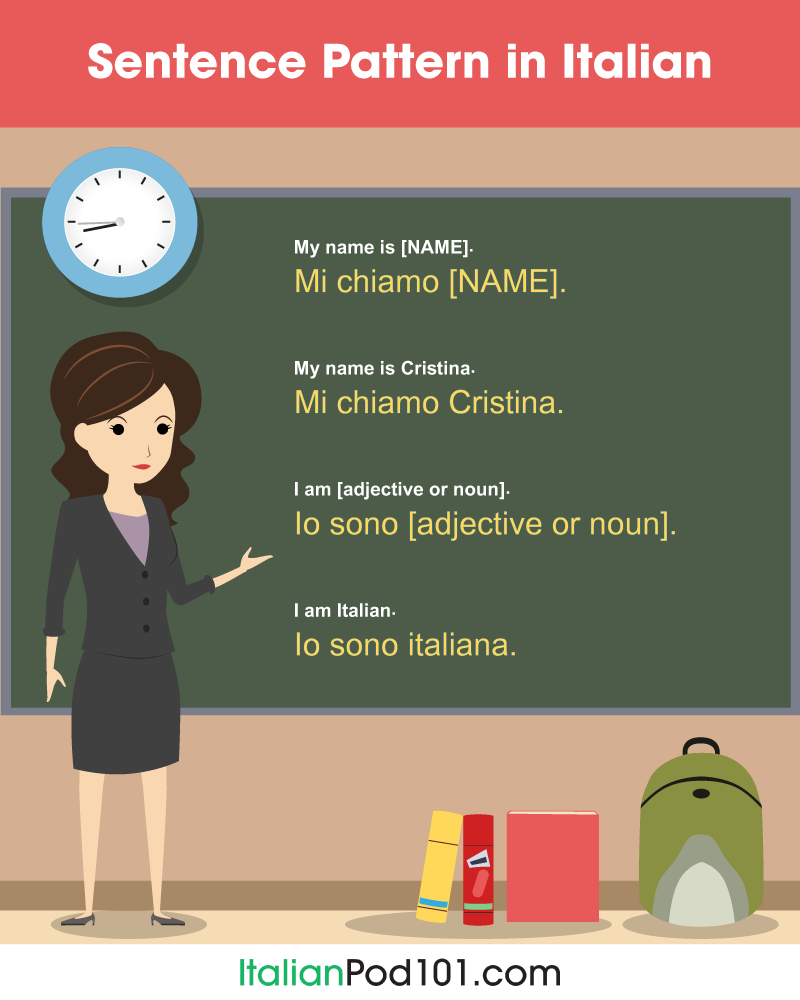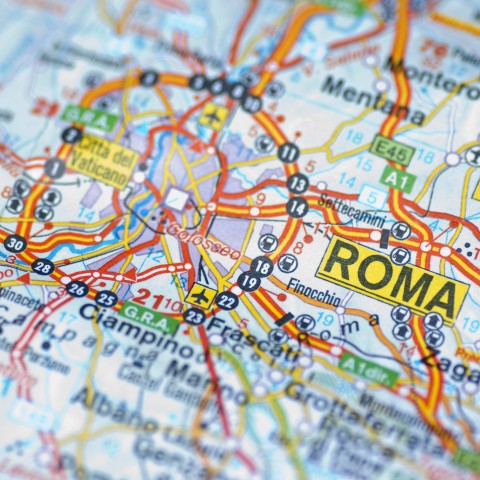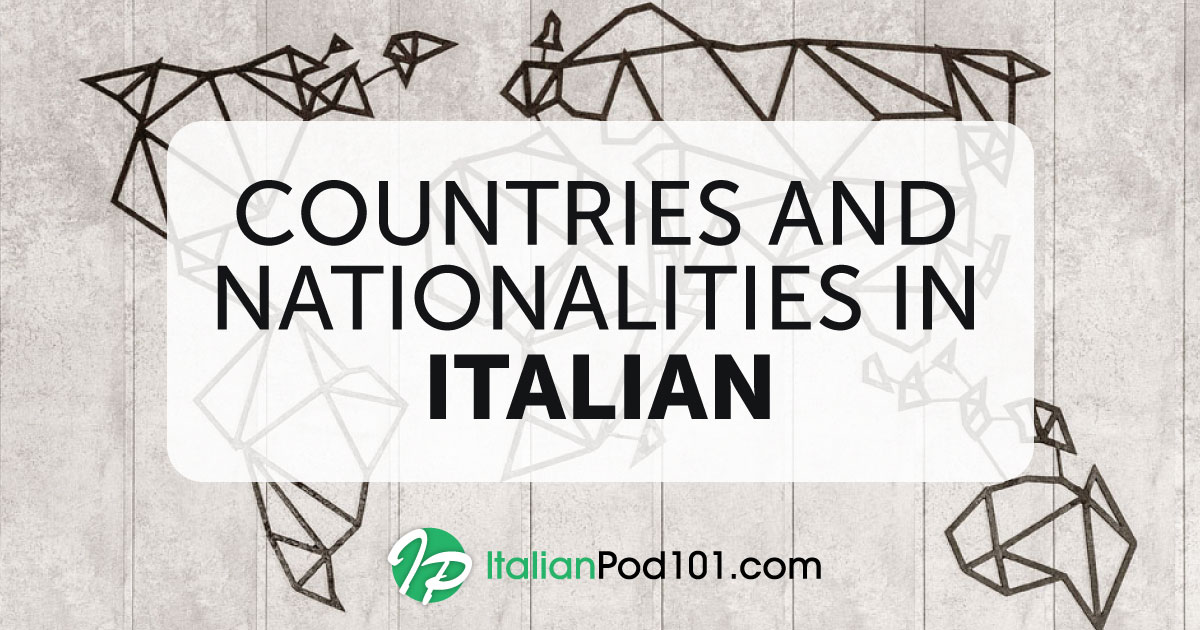
Have you ever asked yourself how we learn our native language when we’re kids? We keep hearing and repeating the same simple sentences over and over. That’s the only trick!
As an adult, it works the same way: You memorize a sentence structure, then you start changing the elements a little, and in the end, you start making the sentences more complex.
With this simple guide on forming sentences in Italian, we’ll help you memorize the most basic and useful Italian sentence patterns; with those, you’ll be able to generate hundreds of natural sentences. And in no time, you’ll be holding complex conversations with ease and confidence.
 Table of Contents
Table of Contents
- A is B: L’italiano è bello!
- Voglio imparare l’italiano con ItalianPod101.com!
- Love is all you need…
- Mi piace l’italiano!
- Bella Ciao and the Reflexive Verbs
- Asking politely: Scusi, posso…?
- Asking Questions
- Conclusion
1. A is B: L’italiano è bello!

In Italian, if you want to describe a person or an object, you need to be able to say that A is B. Nothing’s easier! The only thing is that you need to know how to use and conjugate the verb essere (“to be”). And once you master that, you need to keep in mind that everything in Italian needs to agree in number (singular/plural) and gender (masculine/feminine).
- Mario è mio fratello. (“Mario is my brother.”)
- Maria è mia sorella. (“Maria is my sister.”)
There are already a lot of things you can say using this pattern:
- (Lei)* È professoressa di italiano. (“She is an** Italian teacher.”)
- (Voi) Siete molto simpatici. (“You are very nice.”)
- Gli amici sono americani. (“The friends are American.”)
*Notice how, in Italian, you don’t need to express the personal pronoun when it’s the subject of the verb (io, tu, lui/lei, noi, voi, loro), **and when you say someone’s profession, you can omit the article:
- (Io) Sono avvocata. (“I’m a lawyer.”) [for a female speaker]
- (Tu) Sei ingegnere. (“You are an engineer.”)
- Carlos è studente. (“Carlos is a student.”)
But what about when you want to say that A is not B? No problem. Anytime you need to express a negative statement, you just add the negation non (“not”) in front of the verb, as in:
- Maria non è mia sorella. (“Maria is not my sister.”)
- Questo orologio non è un regalo. (“This watch is not a present.”)
Notice also how the basic Italian sentence structure doesn’t change with most of the tenses (past, future, etc.).
- Giovedì sarà il mio compleanno. (“Thursday will be my birthday.”)
- Mario non era un bravo calciatore. (“Mario wasn’t a good soccer player.”)
And finally, if you need to ask a question, remember that, in Italian, you don’t need to do much. Just change your intonation, and you’ll have a perfect question.
- Sei ingegnere? (“Are you an engineer?”)
- Mario non era un bravo calciatore? (“Wasn’t Mario a good soccer player?”)
When we use adjectives to describe a person, a thing, or a situation, the structure stays exactly the same, including in the negative form or in other tenses:
- (Tu) Sei bellissima! (“You are very beautiful!”)
- La lasagna era deliziosa. (“The lasagna was delicious.”)
- Il museo che abbiamo visitato ieri era molto interessante. (“The museum we visited yesterday was very interesting.”)

The rose is red…[A] is [B]
2. Voglio imparare l’italiano con ItalianPod101.com!
Voglio (“I want”) is one of the Italian modal verbs (verbi servili) that are constructed by directly preceding the infinitive.
- Voglio imparare l’italiano con ItalianPod.101! (“I want to learn Italian with ItalianPod101.com!”)
- Devo parlare. (“I have to speak up.”)
- Posso fare. (“I can do it.”)
- So suonare. (“I know how to play.”)
You can probably guess by now what the pattern is for the negative and interrogative forms. Yes, you’re right! For the negative form, you just put non (“not”) in front of the verb; if you want to ask a question, you just change the intonation:
- Non voglio andare a scuola domani! (“I don’t want to go to school tomorrow!”)
- Sai suonare il sassofono? (“Can you play the saxophone?”)
Italian phrases change a little when we start using direct or indirect personal pronouns, which we can put in front of the conjugated verb (as usual):
- Lo voglio dire. (“I want to say it.”)
Or, we can attach it to the end of the infinitive:
- Lo voglio dire; = Voglio dirlo; (“I want to say it.”)
- Ti devo parlare; = Devo parlarti; (“I have to talk to you.”)
- Lo possiamo fare; = Possiamo farlo; (“We can do it.”)
- La so suonare; = So suonarla; (“I can play it.”)
3. Love is all you need…
Although it might be true that “All you need is love,” in the real world, outside of dreamy songs, we need a lot of things. In Italian, “to need” translates into avere bisogno di. It’s a slightly different structure than in English and you’d better get familiar with it, because when you travel to Italy, or when you’re in the company of Italian friends, you might need to say one of the following:
- Avete bisogno di informazioni? (“Do you need information?”)
- Hai bisogno di cambiare i soldi. (“You need to change the money.”)
- Il bambino ha bisogno di mangiare subito! (“The kid needs to eat right away!”)

Abbiamo bisogno d’amore! (“We need love!”)
Let’s take a look now at this Italian language sentence structure.
You’ve probably noticed that we’re conjugating the verb avere (“to have”), which means that the literal translation of avere bisogno di is “to have the need for.” The noun bisogno (“need”) never changes, regardless of who the subject is, or who or what you need.
Another important thing to remember is that the thing you need is introduced by the preposition di (“of”). When prepositions meet the article, they usually merge into a preposizione articolata.
- Ho bisogno del (=di + il) bagno. (“I need the bathroom.”)
- Hai bisogno della (=di + la) macchina? (“Do you need the car?”)
When what you need is expressed by an action (and therefore a verb) you can change the sentence by replacing avere bisogno di (“to need”) with dovere (“to have to”). Like in English, the final meaning in Italian is basically the same, with maybe just a slight difference:
- Ho bisogno di mangiare altrimenti svengo. (“I need to eat, otherwise I’ll faint.”) >> It’s necessary.
- Devo mangiare altrimenti svengo. (“I have to eat, otherwise I’ll faint.”) >> I have no choice.
4. Mi piace l’italiano!
In Italian, the verb piacere expresses the concept of “liking” something, and of showing tastes and preferences. Piacere uses a particular sentence structure: What you like (or don’t like) is the subject of the verb, while the person who likes (or dislikes) someone/something is expressed with an indirect personal pronoun.
If you try to translate it literally into English, you’ll have to change the order of the words a bit. Take a look:
- Mi piace la pasta. (Mi = a me) > “I like pasta.”
- Ti piace la pasta. (Ti = a te) > “You like pasta.”
- Le piace la pasta. (Le = a lei) > “She likes pasta.”
- Gli piace la pasta. (Gli = a lui) > “He likes pasta.”
- Ci piace la pasta. (Ci = a noi) > “We like pasta.”
- Vi piace la pasta. (Vi = a voi) > “You like pasta.”
- A loro piace la pasta. > “They like pasta.”
Can you see what happened here? In the Italian translation, the grammatical subject is no longer “I” (io); it turned around to be the pasta! So if we go for the literal English translation, it would be “Pasta (subject) pleases (third person plural verb) me.”
If the thing you like is plural, you use piacciono (“they please”).
- Mi piacciono gli spaghetti. > “I like spaghetti.”
- Ti piacciono i fumetti di Diabolik? > “Do you like Diabolik comic books?”
- Non ci piacciono le brutte notizie. > “We don’t like bad news.”
The verb piacere can also be followed by an infinitive.
- Non gli piace guidare. > “He doesn’t like to drive.”
- Ti piace ballare? > “Do you like dancing?”
- Mi piace camminare a piedi nudi. > “I like to walk barefoot.”
Many other verbs use the same Italian sentence construction as piacere. For example:
- Dispiacere (“to be sorry”) >> Mi dispiace per la confusione. (“I’m sorry for the mess.”)
- Bastare (“to suffice”/”to be enough”) >> Ci basta poco. (“We don’t need much.”)
- Mancare (“to miss something or someone”) >> Mi manca molto. (“I miss it a lot.”)
- Servire (“to need”) >> Gli servono due pomodori. (“He needs two tomatoes.”)
- Interessare (“to be interested in”) >> Ti interessa la storia? (“Does history interest you?”)
- Sembrare (“to seem”/”to appear”) >> Ci sembra molto bello. (“It seems very nice to us.”)
- Dare fastidio (“to annoy”/”to bother”) >> Mi dai proprio fastidio. (“You really bother me.”)
5. Bella Ciao and the Reflexive Verbs
Lately, the traditional hymn of freedom and resistance Bella Ciao has become very popular. But have you ever realized how it’s also a hymn to the power of reflexive verbs? Just look at the very first lyrics:

Is it a protest or a bank robbery…? 😉
Una mattina mi son(o) svegliato,
o bella ciao, bella ciao, bella ciao ciao ciao!
Una mattina mi son(o) svegliato
e ho trovato l’invasor.
One morning I awakened,
oh bella ciao, bella ciao, bella ciao, ciao, ciao!
One morning I awakened
And I found the invader.
One very common structure in Italian is to use reflexive verbs. These verbs express that the subject and the object of the action are the same:
- (io) mi sono svegliato. (“I woke up.” Literally: “I woke myself up.”)
- (io) mi lavo le mani. (“I wash my hands.” Literally: “I wash myself the hands.”)
As you can see from the examples above, the reflexive verb is always preceded by a reflexive pronoun. So the pattern is always:
[subject] [reflexive pronoun – same person as the subject] [verb]
[Maria] [si – (lei)] [sveglia]
Further, an Italian sentence that uses reflexive verbs requires the auxiliary essere (“to be”) in the past and all compound tenses. It also needs the consequent agreement of the past participle with the subject, as usual.
- Si sono sposati l’anno scorso. (“They got married last year.”)
- Carla, ti sei arrabbiata con me? (“Did you get angry at me?”)
- Ieri non mi sono rasato. (“Yesterday, I didn’t shave.”)
In Italian, many common reflexive verbs are those related to routine daily actions. Reflexive verbs, in the infinitive form, will have the third person reflexive pronoun -si attached to the end, which can be a little confusing. Let’s see a few examples to clear things up.
Svegliarsi (“to wake up”) > Mi sveglio alle sei. (“I wake up at six.”)
Alzarsi (“to get up”) > Ti alzi? (“Do you get up?”)
Lavarsi (“to wash up”) > John si lava solo la domenica. (“John washes up only on Sunday.”)
Vestirsi (“to dress up”) > Mi vesto per andare alla festa. (“I dress up to go to the party.”)
Mettersi (“to wear”) > Non ti metti il vestito rosso? (“Don’t you wear the red dress?”)
Pettinarsi (“to comb”) > Jessica non si pettina mai. (“Jessica never combs her hair.”)
Radersi (“to shave”) > Si rade un giorno sì e un giorno no. (“He shaves every other day.”)
Truccarsi (“to put on makeup”) > Le bambine si truccano a Carnevale. (“Girls put on makeup for Carnival.”)
Addormentarsi (“to fall asleep”) > Mi addormento a mezzanotte. (“I fall asleep at midnight.”)

Reflecting on reflexive verbs…
Many Italian verbs that express a physical state or a state of mind are also reflexive:
Annoiarsi (“to get/be bored”) > A teatro ci annoiamo. (“We get bored at the theater.”)
Arrabbiarsi (“to be angry”) > Perché ti arrabbi? (“Why do you get angry?”)
Chiamarsi (“to be called”) > Ciao, mi chiamo Elena. (“Hi, I’m called Elena.”)
Divertirsi (“to have fun”) > Sono sicura che vi divertiete. (“I’m sure you’ll have fun.”)
Innamorarsi (“to fall in love”) > Mi sono innamorata di te. (“I fell in love with you.”)
Lamentarsi (“to complain”) > Si lamentano sempre. (“They complain all the time.”)
Preoccuparsi (“to worry”) > Non ti preoccupare. (“Don’t worry.”)
Rilassarsi (“to relax”) > La domenica mi rilasso in famiglia. (“On Sunday I relax with my family.”)
Sedersi (“to sit down”) > Ci sediamo un poco? (“Shall we sit down for a while?”)
Sentirsi (“to feel”) > Non ti senti bene? (“Aren’t you feeling well?”)
Sposarsi (“to get married”) > Si sposano a maggio. (“They get married in May.”)
Vergognarsi (“to be ashamed”) > Mi vergogno di quello che ho fatto. (“I’m ashamed of what I’ve done.”)
6. Asking politely: Scusi, posso…?
1- Posso?
There are many situations where you need to politely ask to go someplace, or to get information or a service. Here’s the correct Italian language sentence pattern for you to use in order to make the best impression with your politeness.

Posso andare al bagno? (“May I go to the bathroom?”)
As in English, Italian uses the verb potere (“can”/”may”), followed by an infinitive, to ask for permission to do or get something.
- Posso entrare? (“May I come in?”)
- Posso andare in bagno? (“Can I go to the bathroom?”)
- Posso alzarmi da tavola? (“Can I be excused?” Literally: “Can I leave the table?”)
- Posso avere il tuo numero di telefono? (“Can I have your phone number?”)
2- Scusa… Scusi…
Often, before asking for something, Italians say Scusa… (informal) or Scusi… (formal). But what does that mean? It’s actually a short version for saying “Excuse me,” and in some situations, it can also be used to say “Sorry.” But going back to the sentence pattern for politely asking for something, scusa is a way to draw the attention of the person you’re about to ask permission from.
- Scusi, posso entrare? (“Excuse me, may I come in?”)
- Scusa, posso avere il tuo numero di telefono? (“Excuse me, can I have your phone number?”)
A common situation where you should use this structure is when you’re at a coffee bar or a restaurant, and you want to draw the waiter’s or bartender’s attention before making your request:
- Scusi, posso avere un cappuccino? (“Excuse me, can I get a cappuccino?”)
- Scusi, possiamo avere il conto? (“Excuse me, can we have the bill?”)
Or, if you’re lost in Milan or Rome and you need directions (or the time):
- Scusi, può dirmi come arrivo al Duomo? (“Excuse me, can you tell me how to get to the Duomo?”)
- Scusi, può dirmi che ore sono? (“Excuse me, can you tell me the time?”)
Remember to use the formal version, scusi, when you talk to an older person, someone you don’t know, or anyone you want to show respect to (and with waiters and bartenders). The informal scusa is for young people, friends, and family.
3- Potrei…?
Finally, another way to ask politely for something in Italian is to use the present conditional. This shows that you’re asking something, but you’re not ordering. You’re rather expressing a wish.
- Potrei avere un cappuccino? (“Could I have a cappuccino?”)
- Mi farebbe un cappuccino? (“Could you make me a cappuccino?”)
- Mi potresti dire l’ora? (“Could you tell me the time?”)
7. Asking Questions
1- About things: Che cos’è …?
Cosa (“thing”) is the most indeterminate and comprehensive word in the Italian language. With the word cosa, you can indicate anything that exists, whether in an abstract sense or in reality. It’s also the interrogative pronoun we use to ask about things when we want to know what they are, what they do, etc.

Cosa? Dove? Quando? Too many questions!!!
It’s interesting to notice how there are different ways to say “what” in Italian:
- Che
- Cosa
- Che cosa
These pronouns are always followed by a verb, either essere (if you’re asking what things are), or any other verb (if you’re asking about any other thing).
- Che fai stasera?
- Cosa fai stasera?
- Che cosa fai stasera?
What’s the difference between the above sentences? None whatsoever. They all mean: “What do you do tonight?” Similarly, the following sentences all mean: “What is an interrogative pronoun?” (By the way, if you want to know more about interrogative pronouns in Italian, you can review all about pronouns on ItalianPod101.)
- Che è un pronome interrogativo?
- Cos’è un pronome interrogativo?
- Che cos’è un pronome interrogativo?
Did you see what happened with cos’è (in cos’è successo)? When you have cosa + è, the final “a” is dropped, and you add an apostrophe (‘) to indicate that there was an elision. This is quite common in Italian, and we’ll see more examples of this in the next chapter.
2- Asking about a location: Dov’è …?
It might be true that all roads lead to Rome, but when you’re in Rome and you need directions to get around, what do you do? For that, you simply use the adverb dove (“where”). Remember what happened with cosa + è = cos’è (elision). The exact same phenomenon happens here: dove + è = dov’è.
- Dov’è il bagno? (“Where is the bathroom?”)
- Dove si prende l’autobus? (“Where do we take the bus?”)
- Dove va questo treno? (“Where does this train go?”)

All the roads lead to Rome, but you can still get lost…
Another common way to ask where things are is by using the verb trovarsi. It’s a reflexive verb meaning “to find oneself” / “to happen to be” / “to be situated.”
- Dove si trova il bagno? (“Where is the bathroom?”)
- Dove mi trovo? (“Where am I?”)
And finally, you can hear Italians use the verb stare (literally “stay”) to indicate where things are (especially within Rome):
- Dove stanno i miei calzini? (“Where are my socks?”)
- Stanno nel primo cassetto, come sempre! (“They are in the first drawer, as always!”)
3- Asking about time: Quand’è?
Tell me Quando Quando Quando…
This old Italian standard from the ‘60s is the perfect soundtrack to introduce the final basic Italian sentence pattern: Asking about time. Quando (“when”) is used pretty much the same way as the other interrogative words, including the trick quando + è = quand’è.
- Quand’è il tuo compleanno? (“When is your birthday?”)
- Quando arriva il treno? (“When does the train get in?”)
- Quando cominciano le vacanze di Natale? (“When does the Christmas vacation start?”)
Obviously, you use quando if you mean to ask a general question about time, but you can change the formula if you want to be more specific:
- In che anno sei nato? (“What year were you born?”)
- A che ora arriva il treno? (“What time does the train get in?”)
- Che giorno cominciano le vacanze di Natale? (“What day do the Christmas vacations start?”)

8. Conclusion
Do you think you know enough about the most useful Italian sentence structures now? Do you feel confident about diving into a conversation in Italian, using basic sentences, questions, and polite requests? What about discussing your likes and desires?
Let us know if there’s any other topic or sentence pattern that you would like to learn more about. And make sure to explore our site, ItalianPod101.com, to take advantage of our free resources, vocabulary lists, and mobile apps to practice whenever and wherever you want.
Remember that you can also use our premium service, MyTeacher, to learn Italian with your own teacher. You’ll also continue to study at your own pace with fast, fun, and easy Italian lessons, including 220+ hours of audio/video courses, study tools, and more!










